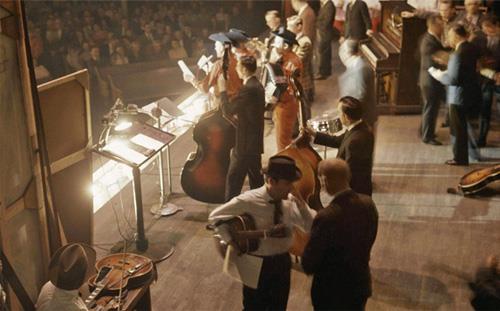
Mississippi native Marty Stuart is the most prominent and recurring commentator in Ken Burns’ eight-episode, 16½ hour documentary miniseries, Country Music, which will debut on PBS from September 15-18 through 22-25. (It’s also available simultaneously for streaming worldwide at https://www.pbs.org/show/country-music/.)
The point of Country Music is that this genre is deeply rooted in the musical traditions of both Europe and Africa, and migrated to the Appalachian Mountains, the deep South and the American Southwest, and flourished in these regional settings at impromptu pickin’ parties, community barn dances, and Sunday morning gospel singalongs.
Stuart himself explains as much in Episode Five. “It was almost like a badge of honor,” he says, “that you had to bring your culture with you to the table. That’s why Bob Wills and his guys brought his Western music. That’s why Hank Williams brought the South from Honky Tonk. Johnny Cash brought the black land dirt of Arkansas. Bill Monroe brought music out of bluegrass Kentucky. Willie Nelson brought his poetry from Texas. Patsy Cline brought her heartache from Virginia. It was the most wonderful parade of sons and daughters of America who brought their hearts and souls and experiences.”
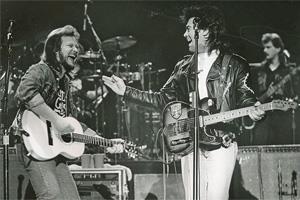 For his part, Marty Stuart (right, with Travis Tritt) is today a multiple Grammy Award-winning singer-songwriter, but at one time he was a self-taught teenage prodigy on the mandolin and guitar. He was so good, in fact, he was invited to join Lester Flatt’s band at 14 in 1972 and went on the road with them through 1978. He later played in Johnny Cash’s backup band for five years before landing his own recording contract with Columbia Records in 1985, which jump-started his solo career. He, like the more than three dozen other filmed interviewees in Country Music,is a veteran insider who knows whereof he (or she) speaks.
For his part, Marty Stuart (right, with Travis Tritt) is today a multiple Grammy Award-winning singer-songwriter, but at one time he was a self-taught teenage prodigy on the mandolin and guitar. He was so good, in fact, he was invited to join Lester Flatt’s band at 14 in 1972 and went on the road with them through 1978. He later played in Johnny Cash’s backup band for five years before landing his own recording contract with Columbia Records in 1985, which jump-started his solo career. He, like the more than three dozen other filmed interviewees in Country Music,is a veteran insider who knows whereof he (or she) speaks.
On this project, Stuart and his country musical peers have warmly embraced and supported Ken Burns and his creative team—which includes his lead producer and head writer, Dayton Duncan, and co-producer Julie Dunfey—with equal parts ease and intimacy that come shining through their many onscreen contributions to Country Music. As Burns recently shared during his July 29 appearance with Stuart, Roseanne Cash, and Dwight Yoakam at the 2019 Television Critics Association summer press tour in Los Angeles that “you join a family” when you become a serious fan of country music like he has.
Country music is sometimes misunderstood and pigeonholed as being mostly white and rural, politically and religiously conservative, and musically uncomplicated and direct. To put it succinctly, the opening of Country Music reprises Nashville Hall of Fame songwriter Harlan Howard’s well-known description of a country song as being “three chords and the truth.” This oft-quoted trope captures the downhome and democratic aspirations of the genre, which is to tell everyday stories that are sincerely expressed, authentically felt, and relatable to the life experiences of its target audience.
 Dolly Parton (left) speaks to these humble and heartfelt uses of the genre within the first five minutes of Episode One: “The Rub” (Beginnings-1933), when she confirms that “it’s just simple ways of telling stories, experiencing and expressing feelings. You can dance to it. You can cry to it. You can make love to it. You can play it at a funeral. It just has something in it for everybody.” The “rub,” too, is a defining characteristic of the genre, according to Ketch Secor. “I think friction is a good way to look at the music,” he explains, “this rub between white and black. Country music comes from the South because this is where slavery happened.”
Dolly Parton (left) speaks to these humble and heartfelt uses of the genre within the first five minutes of Episode One: “The Rub” (Beginnings-1933), when she confirms that “it’s just simple ways of telling stories, experiencing and expressing feelings. You can dance to it. You can cry to it. You can make love to it. You can play it at a funeral. It just has something in it for everybody.” The “rub,” too, is a defining characteristic of the genre, according to Ketch Secor. “I think friction is a good way to look at the music,” he explains, “this rub between white and black. Country music comes from the South because this is where slavery happened.”
Race and place always have been the “connecting thread” in all of Ken Burns’ work, and once again are front and center in Country Music. Local music influences are everywhere, and race is crucial also. For example, some artists of color, such as DeFord Bailey, who was one of the original headliners at the weekly Grand Ole Opry radio program from 1927 to 1941, is recredited as a pioneering performer and harmonicist. Wynton Marsalis, the most prominent voice in Burns’ Jazz, offers several onscreen observations throughout Country Music involving the creative interplay between the blues, jazz, and country music and its implication concerning race relations.
More hidden from historical view and recovered in the miniseries are the numerous references to unknown or little known African-American musicians who influenced future white country stars, such as Jimmie Rodgers’ blue yodel style, picked up while working alongside black railroad workers in Mississippi; blues guitarist Rufus “Tee Tot” Payne’s mentorship of a preteen Hank Williams in Alabama; and banjo playing-songwriter Gus Cannon, who took 22-year-old Johnny Cash under his wing in Memphis, Tennessee, in 1954. Marty Stuart delivers a foregone conclusion by Episode Three: “The Hillbilly Shakespeare” (1945-1953) when he asserts that “the black music influence in country music is immeasurable.”
What is acknowledged but more difficult to decipher are the borrowings, reworkings, and occasional appropriations that have been a regular part of country music, especially when different styles evolve, mix, match, and collide with each other, resulting in new techniques, sounds, and subgenres. For instance, the country music establishment did not know what to do with the young Elvis Presley. Born in Tupelo, MS, the so-called “Hillbilly Cat” was invited to perform at the Grand Ole Opry in 1954, and sang a speeded-up rock-tinged version of Bill Monroe’s bluegrass classic, “Blue Moon Over Kentucky.” He was never asked back. “When I saw Elvis,” Monroe later confessed, “I thought I was seeing the beginning of the end of the music I loved.”
In the early-to-mid 1950s, Elvis and Johnny Cash were sent out on tour together, usually as opening acts for more established country stars. A Depression baby, Cash grew to love and listen to all genres of music, and he was even more stylistically diverse than Presley. Where Elvis’s singing incorporated African-American intonations and rhythms, Cash’s deep baritone was sui generis.
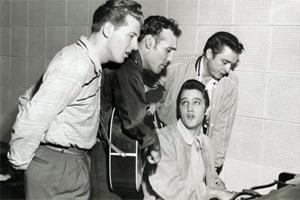 Producer Sam Phillips of Sun Records in Memphis signed them both to contracts, along with Howlin’ Wolf, B.B. King, and their rockabilly contemporaries, Carl Perkins, Jerry Lee Lewis, and Roy Orbison. In so doing, Phillips claimed he “knocked the shit out of the color line.” Elvis soon emerged as the “King of Rock ‘n’ Roll,” while Cash became an iconic superstar in country music over his more than five decades in the limelight. The miniseries gradually follows his career arc across the majority of episodes, as Cash evolves professionally and personally into the genre’s biggest and most authoritative and signature star ever.
Producer Sam Phillips of Sun Records in Memphis signed them both to contracts, along with Howlin’ Wolf, B.B. King, and their rockabilly contemporaries, Carl Perkins, Jerry Lee Lewis, and Roy Orbison. In so doing, Phillips claimed he “knocked the shit out of the color line.” Elvis soon emerged as the “King of Rock ‘n’ Roll,” while Cash became an iconic superstar in country music over his more than five decades in the limelight. The miniseries gradually follows his career arc across the majority of episodes, as Cash evolves professionally and personally into the genre’s biggest and most authoritative and signature star ever.
Suffice it to say that race as well as class and gender are integral parts of the Country Music narrative that Ken Burns and his creative colleagues construct, whereby this longstanding and rich musical tradition is presented as being animated by the same general tendencies and tensions as American history and culture writ large. The origin story of country music is told towards the end of episode one when New York City-based Victor Records producer, Ralph Peer, travels to the southern Appalachian town of Bristol, which lies on the state line between Tennessee and Virginia.
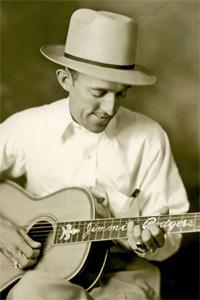 Over a 24-hour period in early August 1927, Peer recorded Jimmie Rodgers and the Carter Family—the “Saturday night” and “Sunday morning” of country music—along with a dozen or so other regional talents. Even polite Southern society looked at these singers and musicians as hillbillies, which at the time meant crude and tacky white trash. The miniseries thus underscores how the elemental impulses of country music are derived from the lower and forgotten rungs of the American social hierarchy.
Over a 24-hour period in early August 1927, Peer recorded Jimmie Rodgers and the Carter Family—the “Saturday night” and “Sunday morning” of country music—along with a dozen or so other regional talents. Even polite Southern society looked at these singers and musicians as hillbillies, which at the time meant crude and tacky white trash. The miniseries thus underscores how the elemental impulses of country music are derived from the lower and forgotten rungs of the American social hierarchy.
The boundary-crossing promiscuousness of country music is illustrated in a vignette from Episode Two: “Hard Times” (1933-1945), involving Carter Family patriarch, A.P. (Alvin Pleasant Delaney Carter), a traveling salesman by trade, who always kept his eyes and ears open to discovering and learning new songs during his frequent work-related treks across Central Appalachia. His most famous find was a funeral hymn written by Charles Gabriel, an African-American minister, that A.P. reworked and recorded with his wife, Sara, and his sister-in-law, Maybelle. Released in 1935, “Can the Circle Be Unbroken (Bye and Bye)” became a trademark recording for the Carter Family and an eventual evergreen classic in the annals of country music.
Starting with the original Carter Family trio, Burns and his production team give proper due to the many talented women singer-songwriters and musicians who decades later would eventually crack the glass ceiling in what would be largely a male-dominated industry throughout the remainder of the 20thCentury. Sara and Mother Maybelle Carter laid the groundwork with the former’s strong, distinctive, country-accented singing style and the latter’s innovative and influential guitar-playing, nicknamed the “Carter scratch,” whereby she picked and strummed the lead and rhythm lines of the songs all at once on her instrument.
Country Music is given the full Ken Burns treatment, which from a narrative perspective means blending a chronological approach with a series of dramatic biographies that serve as the foundational structure of this historical documentary. Besides the original Carter cousins, Sara and Maybelle, and the latter’s daughters, Helen, June, and Anita, the miniseries devotes ample attention to pioneering female talents such as Kitty Wells from Tennessee; Wanda Jackson, the “Queen of Rockabilly,” from Oklahoma; strong and sassy Patsy Cline from Virginia, who mentored petite teen star, Brenda Lee, from Georgia; Tammy Wynette from Mississippi; but especially, Loretta Lynn from Butcher Hollow, KY, Dolly Parton from the Great Smokey Mountain region of East Tennessee; and Emmylou Harris from Alabama and Virginia.
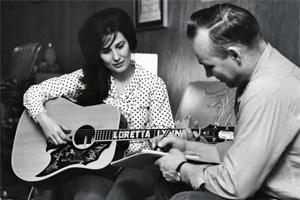 In particular, Loretta Lynn (left) is depicted as a trailblazing force of nature with the cards stacked high against her as a poor woman from the backhills of Kentucky trapped in an often-repressive and tumultuous marriage. In Episode Five, she proclaims to the camera, “I’ve seen it or I’ve lived it.” In Episode Four: “I Can’t Stop Loving You” (1933-1963), Merle Haggard observes admiringly, “she wanted out of the life she was in and she sang her way out of it.” Lynn was a no-holds-bar autobiographical songwriter with such personally revealing hits as “Don’t Come Home A-Drinkin’ (With Lovin’ on Your Mind),” “Coal Miner’s Daughter,” and “The Pill,” along with an estimated 150 other tunes in her catalog.
In particular, Loretta Lynn (left) is depicted as a trailblazing force of nature with the cards stacked high against her as a poor woman from the backhills of Kentucky trapped in an often-repressive and tumultuous marriage. In Episode Five, she proclaims to the camera, “I’ve seen it or I’ve lived it.” In Episode Four: “I Can’t Stop Loving You” (1933-1963), Merle Haggard observes admiringly, “she wanted out of the life she was in and she sang her way out of it.” Lynn was a no-holds-bar autobiographical songwriter with such personally revealing hits as “Don’t Come Home A-Drinkin’ (With Lovin’ on Your Mind),” “Coal Miner’s Daughter,” and “The Pill,” along with an estimated 150 other tunes in her catalog.
Singer-songwriter Dolly Parton also became an inspiration for other women as she regularly crossed over musical boundaries and industry barriers during her half-century career. In Episode Seven: “Are You Sure Hank Does It This Way” (1973-1983), Dolly discloses that she consciously adopted the stage persona of the town trollop, explaining that “it cost a lot of money to look this cheap.” Her larger-than-life persona and down-to-earth sense of humor were further enhanced by her immense songwriting talent, which has resulted in 110 charted singles, including such blockbuster hits as “Jolene,” “I Will Always Love You,” and “9 to 5.” “I’m not offended by all the dumb blonde jokes,” she wryly admits on camera, “because I know I’m not dumb, and I’m not blonde either.”
One-time folkie and rocker, Emmylou Harris (below), was more a herald of an imminent generational shift percolating beneath the surface of Music City U.S.A. during the late 1960s. In Episode Six: “Will the Circle Be Unbroken” (1968-1972), Harris’s conversion to country music is sparked by her close collaboration with Gram Parson in the early 1970s, but then it deepens and matures after his untimely death in 1973 as she emerges at the forefront of the country rock and later roots movements. Her subsequent output produced alone and with dozens of other musical innovators is now recognized and respected in- and outside of Nashville as a pivotal moment in the evolution of the genre. Rolling Stone summed it up by describing her music as “country without the corn.”
 Ending with Episode Eight: “Don’t Get Above Your Raisin’” (1984-1996) Ken Burns and Dayton Duncan avoid the narrative pitfall of Jazz (2001) by remaining resolutely historical throughout, ending Country Music in the mid-1990s with the ascendancy of Garth Brooks, instead of attempting to reference every significant branch of country music’s evolutionary tree up through the first two decades of the 21stcentury.
Ending with Episode Eight: “Don’t Get Above Your Raisin’” (1984-1996) Ken Burns and Dayton Duncan avoid the narrative pitfall of Jazz (2001) by remaining resolutely historical throughout, ending Country Music in the mid-1990s with the ascendancy of Garth Brooks, instead of attempting to reference every significant branch of country music’s evolutionary tree up through the first two decades of the 21stcentury.
The biggest takeaway in Country Music is that it is not one distinct, static category. Its roots are an amalgam of folk music, the blues, gospel, and jazz, but its many expressions and eventual permutations include hillbilly, Country & Western, bluegrass, honky tonk, rockabilly, the Nashville sound, countrypolitan, the Bakersfield sound, outlaw country, country pop, country rock, neo-traditionalist, Americana, roots, country rap, and hick-hop, with more yet to come. “Over 90 years, it’s not just one thing,” concludes Vince Gill in Episode Eight. “That’s the beauty of it. I don’t think I’d enjoy country music if it just stayed the same thing. It’s not supposed to.”
As usual, Ken Burns and company never do things in half-measures. Country Music is a garden of musical delights, whether or not you are a country music fanatic, a casual listener, or a relative newcomer to this sprawling, mellifluous genre. In typical Burns fashion, there are no shortcuts here, with nearly 600 musical cues, over 3,200 period photographs, and two-plus hours of vintage stock footage. There is literally something for everyone. At 16½ hours, moreover, contemporary TV viewing practices have finally caught up with Ken Burns’s all-in commitment to his subjects. Country Music delivers as either a banquet-sized bingeable experience, or a more leisurely savoring of the miniseries at just one two-hour episode at a time.